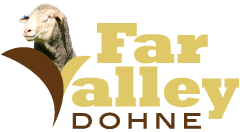By Cameron McMaster
Whatever type or strain of Merino you run, even if you are a specialist wool grower, the number of head marketed per hectare per annum (turnoff) is the single most important factor that influences flock profitability and gross margin. If you have used Dohne rams for the past number of years you will have observed a quite dramatic improvement in reproduction and lamb survival and growth rate. This will have translated into better cash flow from lamb sales, higher profitability and very likely a reduction in fibre diameter and improved wool quality. The vigour, easy care features and ability of the Dohne to utilise less palatable pasture and stubble will have impressed you.
The Dohne is the only Merino that has been designed and selected for more that 70 years for the dual-purpose characteristics of prime lamb production and elite Merino wool in the 19-20 micron range in a self replacing flock. The breeding objective has been designed to increase reproduction and lamb growth rate, maintain fleece weight and reduce fibre diameter. Improving muscle and fat depth are measured characteristics which form an integral part of the selection objective in order to improve carcass quality.
There is ample evidence today that high fleece weights impede reproduction and growth rate. Experience has shown that sheep with a slightly lower potential for wool production are more efficient in terms of meat production and have the added advantage of being plain-bodied, hardy, fit and easy care - traits that also help to reduce production costs.
The influence of lamb weight produced on total income is highly significant and is the reason why the meat component generates the largest proportion of total flock income. Because Dohne ewes are not overburdened with heavy fleeces they have a high meat production potential and can be stocked at higher rates, resulting in higher wool production per hectare - a winning formula for higher profitability.
The large commercial Dohne Flocks in the cropping areas of South Africa average over 130% lambs weaned from ewes that cut in excess of 5 kg of 19.5 micron merino wool. Lambs are marketed off pasture or from feedlots at approximately 5 months of age at carcass weights of 20-22kg. Many of the more efficient properties exceed these production levels.
I was surprised to hear that some wool growers in Australia, having advanced to F3 levels and higher with Dohne rams, are reverting to Polled Merinos. This is a retrogressive step that makes no sense to me and I cannot understand the motivation. It was tried by some breeders in South Africa many years ago with negative consequences. These breeders rapidly lost much of the gain they had made in terms of reproduction and growth rate and the sheep from this back cross were of very mixed type, wrinkly and less vigorous. These breeders very soon went back to Dohne rams.
It makes no economic sense to gain a few grams of fleece weight a generation ahead but immediately lose many kilograms of lamb weight in the process. Much like shooting yourself in the foot!
It is a myth that the Dohne Merino is any way inferior in terms of wool quality and style. As a true dual-purpose Merino, Dohne Merinos originated from a single initial mating of two merino strains more than 70 years ago - the "pure" Merino as we knew it in South Africa then, primarily of Peppin medium wool type, and the Merino developed in Germany from the original Spanish stock, but with greater emphasis on meat production. Throughout the breeding programme there had been consistent backcrossing and upgrading from countless pure Merino flocks in terms of the Dohne Foundation Flock Register, followed by careful selection based on measurement for fertility, meat and merino wool traits. So far as ancestry is concerned the Dohne can therefore claim as much "purity" as any other Merino strain. It is in fact a fine example of the brilliant versatility of the Merino which, throughout the world, has been bred in many shapes and forms to suit vastly differing physical and economic environments.
Here is the formula to maximize the turnoff per hectare - with the added advantage of exponential improvement each year.
- Flock Composition - Maximum number of ewes in relation to total flock - minimum 65 - 70%
- Lamb Growth Rate - The faster the lambs grow, the earlier they can be marketed at better prices, freeing production resources for a higher relative number of breeding ewes. The early marketability of lambs is therefore the key to higher ewe numbers.
- Stocking Density - Maximize turnoff per hectare by carrying the optimum number of ewes for a particular situation. To achieve this level of production ewes must be genetically adapted to these conditions - which relates to the crucial importance of the next aspect.
- Type of Sheep - Ewes must be hardy, easy-care and efficient converters of even low quality feed. They must be non-selective grazers. They must have high reproduction rates, good maternal ability for high lamb survival and good milking ability for high lamb growth. An optimum relationship between wool production and body size is an essential attribute of the type of sheep capable of this level of production under hard commercial conditions. These are the essential attributes of the Dohne Merino.
Experience with this strategy has demonstrated that while meat production increases with more efficient sheep in a self replacing flock, the wool production of the enterprise can be fully maintained and, because of more lambs/hoggets to shear before marketing, it can often be increased.
A new philosophy in terms of breeding goals and selection strategy for Merino Sheep is necessary to maximise profitability in the current and future market environments. To achieve these results use the best Dohne rams you can afford and pursue an effective selection strategy within your own flock to improve reproduction, growth rate and wool quality.

